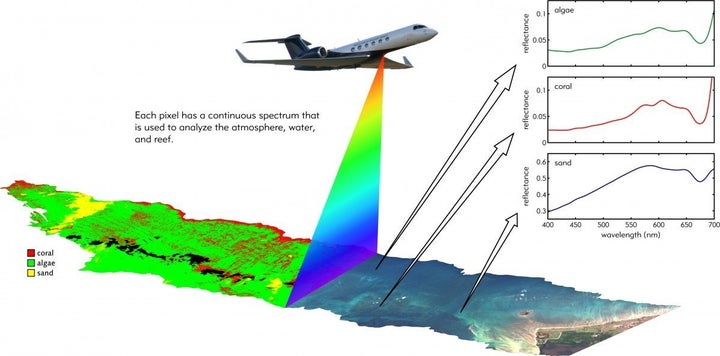NASA's high-tech endeavors normally look outward. But given the existential threat facing the world's coral reefs, the space agency has decided to focus its efforts closer to home -- and the result may be game changing.
We know that warming ocean temperatures, acidification and pollution are threatening coral reefs. But only a small portion of the world's reefs have been studied, which means the extent of the trouble is not well understood.
In hopes of better documenting the state of coral reefs, NASA this year will kick off a three-year field expedition to measure the condition of these vital ecosystems using advanced instruments attached to airplanes.

The campaign, named the Coral Reef Airborne Laboratory, or CORAL, will "survey more of the world’s coral reefs in far greater detail" than ever, according to the space agency.
CORAL principal investigator Eric Hochberg said the current state-of-the-art approach for collecting coral reef data is scuba diving with a tape measure, which is "analogous to looking at a few trees and then trying to say what the forest is doing."
That's where NASA plans to change the game.
Using an airborne instrument called the Portable Remote Imaging Spectrometer, Hochberg and his team will survey key reef systems in Florida, Hawaii, Palau, the Mariana Islands and Australia. By recording the unique spectral signatures of living corals and algae (as corals die, algae numbers increase), the spectrometer will give researchers an extensive picture of what's happening to the world's reefs.
NASA said the collected data will reveal trends between coral reef condition and natural and human-caused factors, allowing scientists to better predict the future of this global ecosystem and to guide policy makers.
"We know reefs are in trouble," Hochberg said, but in order to develop an overarching, quantitative model that describes why and how reefs change in response to environmental changes, accurate data across multiple whole ecosystems is needed.

In October, the National Oceanic and Atmospheric Administration declared the third ever global coral bleaching event -- a phenomenon in which stressed corals expel algae and turn white. If not given time to recover, bleached corals can die.
An estimated 30 percent of the planet's coral has already perished as a result of above-average ocean temperatures, El Nino's effects and acidification. And reef scientists are concerned that most functioning reef ecosystems will disappear by mid-century.
NASA points out that the upcoming CORAL study, while a step in the right direction, will cover only 3 percent to 4 percent of the world's reefs.
"Ideally," Hochberg said, "in a decade or so we'll have a satellite that can frequently and accurately observe all of the world's reefs, and we can push the science and most importantly our understanding even further."
Also on HuffPost:

